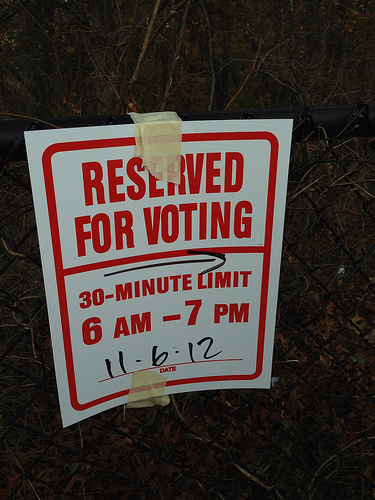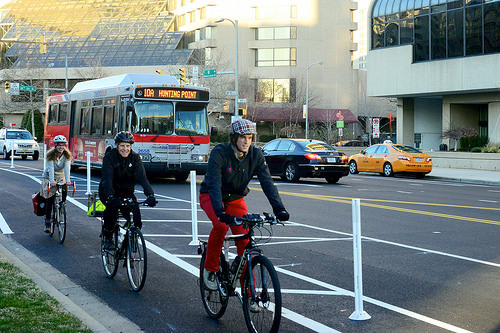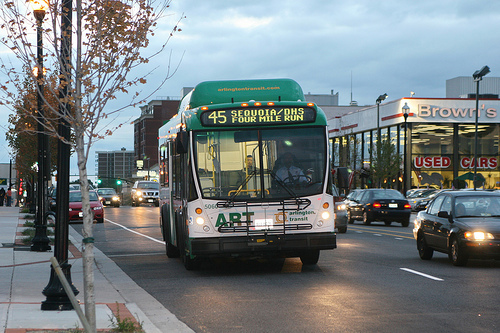Arlington’s upcoming County Board election is a big one. Here’s the scoop on the candidates.
Elections for two seats on the Arlington County Board are on November 3rd. The results will have big implications for the county. Here’s a rundown of where Arlington’s candidates stand on issues related to I-66, bike safety, and transit.
This is the first time since 1975 where two seats are open on the five-member Arlington County Board. Meet the candidates:
- Katie Cristol, though a newcomer to the Arlington political scene, won the most votes in June’s heated Democratic primary.
- Christian Dorsey, the second Democratic nominee (he finished behind Cristol in the primary), is a long-time political activist in Arlington, though he has been less visible in recent years.
- This is Audrey Clement‘s fifth attempt at securing a County Board seat, though this is her first as an Independent rather than under the Green Party label.
- Mike McMenamin has had two failed campaigns under the Republican banner, but is hoping to follow in John Vihstadt’s footsteps and launch a successful campaign as an Independent this year.
- Of note: there are no incumbents. Mary Hynes and Walter Tejada were both up for re-election to the Arlington County Board this year, but after John Vihstadt won a full term and the board canceled the Columbia Pike streetcar, Hynes and Tejada announced they would not run again, leaving the two open seats.
Arlington’s board has undergone massive turnover in the last four years. After this election, Jay Fisette will be the only active board member who was also around at the start of the 2012 session. Will this be a new board finding a new way forward? Will it search out and implement “Smart Growth 2.0,” as departing chair Mary Hynes suggested? Or will it slide back toward the car-dependent policies some of its neighbors are known for?
On Friday night, all four candidates participated in a candidate forum sponsored by the Coalition for Smarter Growth, Arlingtonians for a Clean Environment, the Washington Area Bicyclist Association, and the Sierra Club’s Mount Vernon Group, all organizations that can comfortably be described as pro-urbanism.
Here’s what the candidates had to say:
What to do about I-66
Virginia’s Department of Transportation has long wanted to widen I-66, and Arlington has a long history of fighting it. VDOT finally agreed to do a study that would not just examine widening, but also a range of ways to make traveling inside the I-66 corridor easier.
The results of that study formed the basis of the current VDOT proposal for I-66 inside the beltway: High Occupancy Toll Lanes during both peak travel periods in both directions, the toll money going toward multimodal travel solutions. Also, a a commitment to only widen if the conversion to tolls and multimodal solutions were insufficient to handle congestion on I-66.
Dorsey says that the current VDOT plan needs more work and that he is still waiting to see more data on what effect it will have on traffic. He also is concerned that the tolling project is just a setup for pushing through a widening of the highway.
Cristol, the other Democrat, says she still has a lot of questions about the proposal such as what multimodal solutions the tolls will fund, what impact it will have on Arlington’s local streets and whether tolling the non-peak direction is truly necessary.
Clement supports focusing on better enforcement of the existing HOV rules via “high tech cameras” that can “definitively determine the number of occupants in a car” and stated that if enforcement is insufficent to improve congestion on I-66, that it should switch to HOV-3.
The other Independent, Mike McMenamin expressed support for widening I-66 and stated that Arlingtonians must face that widening is inevitable.
Build more protected bike lanes?
Protected bike lanes are the new gold standard in bicycle infrastructure, as they’re the kind of thing that makes biking attractive and pleasant for everyone, not just the bold or athletic. DC has been moving forward with a network of protected lanes, and Montgomery County has put forth a bold vision for White Flint and is working on a county-wide plan.
Arlington, on the other hand, has a bike plan from 2008 that still thinks sharrows are an exciting new innovation in bike infrastructure, and there’s no concrete plan to update it.
Cristol supports building protected bike lanes “where possible” throughout the community but also stressed that community engagement is key to bike lanes’ success.
In contrast, Dorsey admits that he has a lot to learn when it comes to bike infrastructure, and is open to what people’s experiences are. He isn’t fully convinced that it’s necessary to protect cyclists from cars and noted that he spoke to some cyclists in DC who said they preferred riding in traffic over riding in protected bike lanes.
Clement supports more lanes, but says she’s against building more trails because it would require cutting down trees.
McMenamin says he would consider protected bike lanes on a case-by-case basis and that their impact on drivers is a major concern for him.
How to expand transit
With the Columbia Pike and Crystal City Streetcars cancelled, Arlington is re-examining what the future of transit is for the County as a whole and for Crystal City and Columbia Pike specifically. Will it be Bus Rapid Transit? Personal Rapid Transit? Metrorail expansion?
At the forum, all four candidates spoke in favor of improving Arlington’s transit network, though McMenamin tempered his remarks by asserting that transit is important but not enough; Arlington, he said, also needs to increase its parking supply.
Both Cristol and Dorsey spoke at length about a transit network that supports car-free living by serving trips beyond the regular commute. They also spoke about the current state of Metro and how important it is to turn Metro around, while acknowledging that Arlington cannot do so alone.
Clement wants a reversible lane on Columbia Pike to speed buses in the peak direction of travel and an extension of Metrorail from the Pentagon to Skyline. Beyond that, she claims that Metro’s problems are the direct result of Congress cutting the transit benefit.
Transit-oriented development and parking
Arlington has been a leader in Transit-oriented Development, concentrating growth around its Metro stations to create a series of “urban villages.” The county has seen great success, growing its population and tax base without large increases in traffic congestion.
McMenamin says Arlington needs to get “smarter about smart growth” because in his mind, more cars join the road when places get denser.
Clement has issues with Arlington’s development practices, but for a different reason, saying that while she likes Transit-oriented Development, Arlington has engaged in too much “densification,” which has, in her estimation, increased land values and therefore housing prices.
Dorsey says that Transit-oriented Development is important, but that there are certain types of residential units that can support reduced parking requirements and others, such as large family units, cannot.
Cristol says “stopping development doesn’t solve our problems,” that “growth is better than stagnation,” and that the key to parking reductions is to put alternative transportation options in place.
Arlington residents should be sure to cast their votes in the County board race on November 3rd. What stands out to you? Which candidates are getting your vote? What smart growth messages are getting through to candidates, and which issues do urbanists need to do a better job on?




